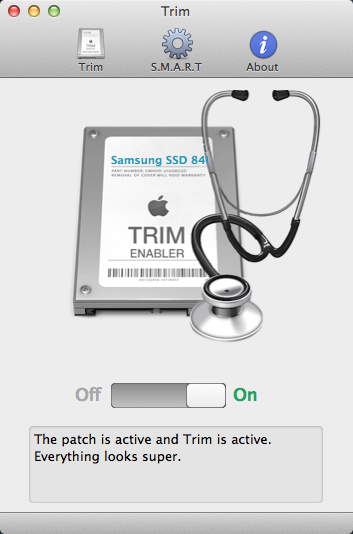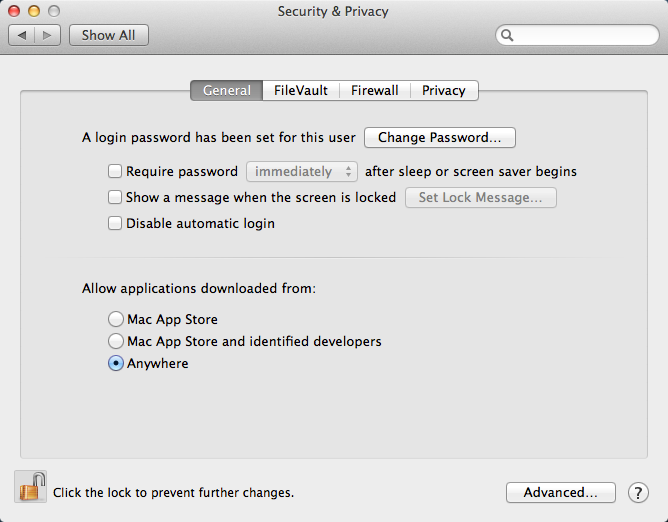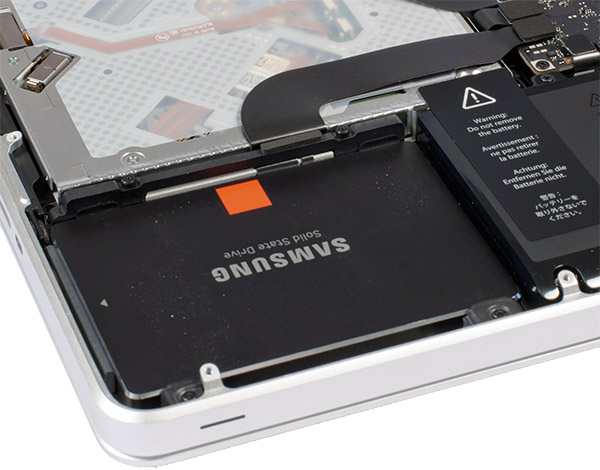Aftermarket SSD On A MacBook Pro: TRIM Gets Tested
The ATA interface standard's TRIM command helps SSDs write faster and live longer. But if you own a Mac, you can only enable it with an OEM drive installed. A freeware tool turns TRIM on for aftermarket SSDs, and we take a look at how well it works.
TRIM Enabler, The Benchmark System, And Software
Again, Apple supports TRIM through OS X, but only when you use one of its OEM drives. Swap out for something else and TRIM gets disabled. We've heard the horror stories about turning it back on through third-party utilities, which is why in our previous piece we did this the hard way:
"Fortunately, the restriction isn't hardwired. There's a bit of terminal window work to lift the Apple SSD requirement, but it's all covered in sufficient depth at Github."
This time, for brevity's sake, we went ahead and gave the TRIM Enabler app a try. It's about as easy to use as you might imagine. Slide a lever from left to right and you're good. Just be aware that operating system updates tend to reverse this process, so you'll need to repeat it if OS X gets patched.
Before TRIM Enabler can be used, the option to allow software installations from anywhere (and not just from the App Store and identified developers) needs to be set in the operating system's settings.
Benchmark System and Software
We're using a MacBook Pro for our benchmark system. To be more specific, it’s the smallest version of the eleventh generation that was introduced in mid-2012, also known as the MacBookPro9,2 model.
The notebook originally came with a 500 GB hard drive, which we took out and dropped into an external USB 3.0 enclosure. Samsung's 840 Pro SSD takes its place. We booted the system from the original hard drive.
Get Tom's Hardware's best news and in-depth reviews, straight to your inbox.
| Apple MacBook Pro | |
|---|---|
| Model | MacBook Pro |
| Model Number | MacBookPro9,2 |
| CPU | Intel Core i5-3210M |
| CPU Clock Frequency | 2.5 GHz |
| Number of Cores | 2 |
| L2 Cache (per Core) | 256 KB |
| Shared L3 Cache | 3 MB |
| RAM | 4 GB |
| System Hard Drive | Seagate ST500LM012 (500 GB; 5400 RPM) |
Benchmark Software
We’re sending the Samsung 840 Pro SSD though two rounds of benchmarks. First, we perform a secure erase, which tells the controller to clear all blocks on the drive. This resets the SSD to the state it shipped in, yielding the best possible performance. We then complete the first round of benchmarks, which consists of running AJA System Test and DiskTester twice without TRIM. This provides a good comparison between fresh out of box and well-used performance.
For the second round, we perform another secure erase, and then we send it through the two benchmark passes with TRIM enabled. This gives us a total of four results:
- TRIM disabled, first pass (brand new)
- TRIM disabled, second pass (well used)
- TRIM enabled, first pass (brand new)
- TRIM enabled, second pass (well used)
A detailed account of a round of benchmarking:
- Only for second round: Install TRIM Enabler and reboot MacBook Pro
- Start AJA System Test benchmark (benchmark file size 16 GB)
- Start DiskTester benchmark (block sizes 4 KB and 8 KB)
- Have DiskTester fill entire SSD with data three times to simulate use
- Fill entire SSD with video data
- Take 30-minute break
- Start AJA System Test benchmark (benchmark file size 16 GB)
- Start DiskTester benchmark (block sizes 4 KB and 8 KB)
Current page: TRIM Enabler, The Benchmark System, And Software
Prev Page Benchmark SSD: Samsung 840 Pro Next Page Results: AJA System Test And DiskTester-
osamabinrobot i think you have an issue with your benchmark graphs, both trim enabled say fresh stateReply -
osamabinrobot i think you have an issue with your benchmark graphs, both trim enabled say fresh stateReply -
steamingabe Any chance you did any real world benchmarks with the stock 500gb drive as well as the 840 Pro?Reply -
halcyon My hat is off to the author for the first 3 paragraphs, to say the least. I'm not sure where I've seen this more succinctly...more clearly explained.Reply
Ah, Apple. Why must it be a love-hate relationship? Clearly, you make some awesome hardware but your pricing and closed-mindedness is @$$munch. You disable TRIM if one doesn't pay 50 to 75% more for one of your lower-performing (than the typical aftermarket piece) OEM SSDs. Shame on you. Greedy bastards. Get with it or continue to decline. It's good to see in the case of TRIM Apple's @$$munchiness is so mindlessly circumvented. ...and to think I once gave them a bunch of my money. 4" Apple...4" -
crisso2face I wish it would be that easy. But its not. The problem with the OS X Trim command it that it kills your SSD. I fried 3 SSD Samsung 840 ( not the pro version ). Im at my 4-th right now ( thx God for warranty ). I work in a laptop store service. So I deal with a lot of laptops on a daily basis. This isn't my firs run in with SSD's. Cant really explain it, not an OS X expert. As soon as I turn on trim, with in a month or so, my SSD dies. This is my personal laptop. As I was saying, I work in a service, I have tech guys which are very good at what they do. If it were a motherboard problem, they would have found it. Its not the laptop ( MacBook Pro 17" Mid 2010 I5, nVidia 330M ). I can't really prove it, I my self, am a guy that needs hard proof, but this isn't a coincidence. 3 SSD's. I just recently had 2 customers with a macbook that asked me to upgrade to an SSD. They both came back to me in a month and a half with a fired SSD. After replacing them i hadn't turned on trim anymore. It's been 3 moths since, and they haven't returned since. Right now I myself use a 4-th SSD Samsung 840 without trim enabled. Haven't had a problem since. You do the math.Reply -
ojas Hey, you know what i'd really like to see? How to enable TRIM/AHCI when you have a MacBook running Windows.Reply
I installed Windows directly, then performed some magic to install bootcamp drivers later, but the problem was that the EFI in Apple PCs disable AHCI when running Windows.
Now Intel'ss SSD toolbox can still perform TRIM even when it's IDE mode (apparently) but i wasn't sure, so i had to Google a solution.
Currently i have to enter four console commands in a GRUB menu before i can boot into Windows over AHCI, and BootCamp doesn't like it when i do.
It's annoying, because i don't know much Linux, and i have no idea how to enable the GRUM menu or some sort of automated boot script that enters those commands for me.
Commands:
setpci -d 8086:2828 90.b=40
set root=(hd0,1)
chainloader +1
boot -
ssdpro There is a big question here: Why does Apple intentionally disable TRIM on non-OEM drives? Think long term - why would Apple, who controls the testing/firmware on OEM storage, know they need to disable TRIM on all 3rd party drives? Are they preventing a problem that is exposed after long term usage of TRIM hacks with their EFI/SMC/OSX code?Reply
Look at crisso2faces comments above - I see that all the time on drives from multiple manufacturers, not just Samsung. Is seeing a couple extra MB/s in a benchmark worth gambling with possible catastrophic failure because you aren't using the system as designed? -
TheCapulet I agree with SSDPro. I know a lot of AppleCare Advisors, so I know first hand how terribly limited Apple Computers are. But the fact of the matter is... it simply comes down to this: If you want "advanced"(lol) features like TRIM support, don't buy an Apple computer.Reply
If you bought a Mac without doing research into your own required features, return it. If you're past your 15 days, look at it as a lesson learned. Macs aren't for everyone. Realistically, Macs aren't for anyone aside from people who want the most watered down experience possible, but the pro apps keep people in line for computers that don't really fit their needs. -
crisso2face The problem with trim on mac is that it has something to do with the comand it self that is sent from the OS X. From what I heard so far, it appears that the command is designed for a limited nr of drives. It has somthing to do with the timing and the blocks or cells of the SSD. The Trim comand of OS X is design for those specific drives. Repecing them with difrent 3rd party drives could prove catastrophic. I dont really understand how that works, up until now i bealived that the comand is basicly the same, no mater of the OS you use. As it turns out ( and i am not yet completely convinced of this ), the comand for trim is NOT the same for all OS's. Apparantly OS X tells the drive to do the trim in some different way, and that wers out the drive very very fast end eventually it dies out. Like I said. Im not an expert, but somthing obviously happens with the drives once you enable trim. Unfortunately I cant take the chance anymore.Reply -
rojjr I am using a 256GB Samsung 830 Pro in a late 2011 iMac using TRIM enabler and I haven't had any problems in 8 months. Before I had this same drive in a 2009 iMac and it performed well also. *fingers crossed*Reply



